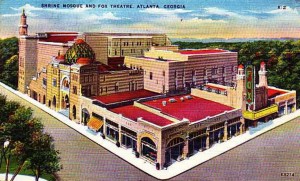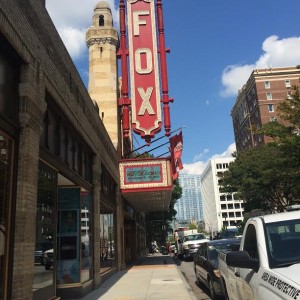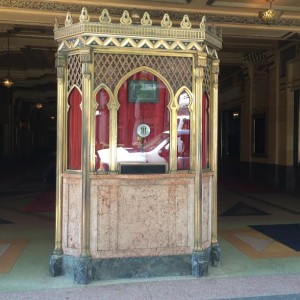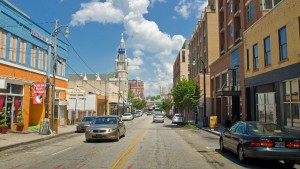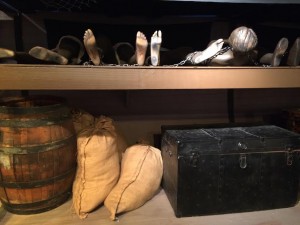
Front View of the APEX museum
The APEX museum, an acronym for African American panoramic experience, is a historical African American museum located on Auburn Avenue in downtown Atlanta. The outside of the building is structured with reddish-brown bricks and elongated white-framed windows. The positioning of the structure is near the end of a corner, making it easy to miss if you are not actively searching for it. The building is rectangular and slightly slanted as a result of its location on a gradual incline. There is a main entrance and a side entrance that allows access to the building. The main entrance appears to be a shop with a standard gold doorknob attached to brown wooden doors where a sign is hung showing the hours of operation. A glass window takes up about half of the door and “The Apex Museum” is written in the middle in alternating black and white letters, placed inside of a red triangle. To the right of this door are two of the elongated white-framed windows that provide a view of the gift shop, which happens to be where the front view of the building ends.

Gift Shop

Connected to the right end corner of the building (viewed from the front) is a yellow iron frame about 12 feet high designed with various swirls and the word “APEX” written in large letters at the very top. This frame is positioned a few feet in front of the side entrance with a red cement walk way leading up to it. Double wooden doors with two golden handles greet you at this entrance, along with a curved red awning about 10 feet high displaying “APEX” in bold white letters. Directly in front of this area is a parking lot that only holds about 35 cars, half of which are spaces reserved for employees. I happened to enter through the side entrance and was immediately greeted by a large gold “Welcome” sign placed inside of a world surrounded by smaller blue words in various languages. To the right of this sign is a marbled dark green wall full of small engraved golden plaques. Titled in gold cursive scripture above read

Side view of APEX
“wall of pride.”

Wall of Pride


Old Trolley
I did not realize that the inside of this building was rather small with only one floor set in a sort of circular motion on behalf of the visitors viewing the content. The first exhibit I visited beyond the “Welcome” wall to the right, brought me to a set of brown double wooden doors with gold handles again. Inside was a replica of an old street trolley from the late 1950’s with the words “ATLANTA RAPID TRANSIT CO” written in large green letters on a white background. The trolley had three rows of seven hard green wooden benches about 10 feet wide and a foot apart. On the wall directly behind the trolley, there were signs advertising black owned businesses on a painted brick wall. These signs included “Ray Simmons Shoe Repair,” “Ma’ Sutton’s Restaurant,” and “Joseph Menefee TAILOR.” The trolley was essentially utilized as a theater, positioned in a way to view three 10 minute videos projected onto the wall ahead.

Signs advertising black owned businesses
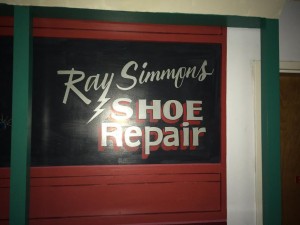

The videos expressed the history of Auburn Avenue in the 1950’s and beyond. From this, I learned that in 1956 Auburn Avenue was named “the richest negro street in the world” by fortune magazine. Many prominent business leaders also became successful here, including Alonzo F. Herdon who was a former slave that founded Atlanta Life Insurance Company; one of the largest and most lucrative businesses in Atlanta during this time. John Wesley Dobbs, an African- American civic and political leader coined the phrase “Sweet Auburn Avenue,” based upon the flourishing area. Below the wall with the projected video is a replica of an older barbershop. On the far right, a two- dimensional faceless couple is dancing. The man wears a red tie with a black suit and white shirt to compliment the lady’s red dress. To the left of this is an old jukebox, a sink, and a mirror. Here, the artificial figure of a man sits in brown pants and a white collard shirt with criss-cross black suspenders, playing the piano.

Old Barbershop
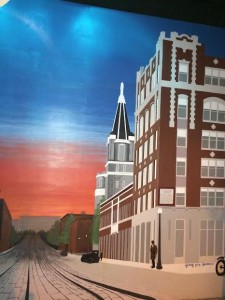
Mural of Auburn
The last item in this room that I recognized was a vibrantly painted mural of Auburn Avenue on the left wall. The figure of a man stands on the corner in front of a reddish building with various white-framed windows. He is next to a light pole and the black wheel of a carriage is shown on the corner. Beyond this building is a slimmer gray structure with a pointy triangular top. There is a gray brick road in front of these buildings lined with trees that ends beyond view. The sky displays a few shades of blue and orange.
The second exhibit brought me through the same doors I entered to an open entrance directly in front of me. Here, I saw a plethora of black and white pictures placed in front of a brick wall aligned with red curtains. These pictures depicted the names, dates, and descriptions of the actions of various black historical figures including Coretta Scott King, Grace Hamilton, and Maynard Jackson. Above these figures, to the left was a silver metal ribbon titled “Hall of Achievement” in cursive blue and red script. The floor was carpeted with a smooth velvety red. On the opposite side, six gold-framed paintings hung on a white wall with black queens placed inside.




African tribal masks
As I exited this room, I was brought in front of a glass case with various African tribal masks and their descriptions. To the right of this was an empty glass case with a picture of the African continent rested on top. The caption read “This case remains empty in remembrance of the art stolen from Africa that now resides in many countries around the world.” Across from the cases were two rectangular canvases placed side by side. The first one showed an old black and white photograph of the APEX museum and had a red strip at the very top with the words “THE WAY WE WERE…” in large white letters. The picture next to it depicted a bustling patriotic city with the same red strip atop, titled “THE WAY WE WILL BE” in the same style.
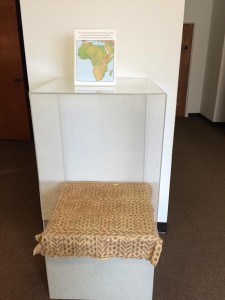

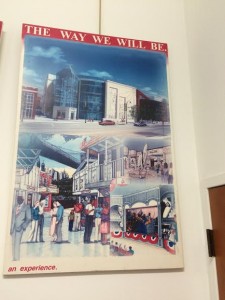
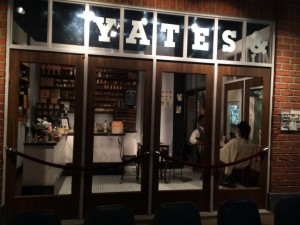
Drugstore
This exhibit placed me down a long hallway with various blueprints of different patents describing inventions and the people who created them. This hallway led me in a circle to the side of the museum where I originally entered. Different exhibits were placed in the open that I had not yet explored. There was a brick drug store with four wooden framed glass windows with “YATES” written in bold white letters at the very top. Two velvet red ropes kept me from entering but inside I could see a gray marbled counter surrounded by wooden shelves filled with various products. A small empty table was placed near the door with black metal chairs.

Hallway of inventions

Blueprint of patents
Across from this exhibit was a slave ship that held two decks. The top deck was expressed with four small canvases depicting the events that occur above. White clouds are painted on a larger blue canvas directly behind these pictures. The first picture is of two white men with blonde hair in matching navy blue shirts with horizontal white stripes and white pants. Two black slaves appear to be battering them. The first man is holding an object for bludgeoning, dressed in only white shorts with no shirt or shoes. The second man is clothed in a gray top and pants with his left fist balled up, placed in a fighting stance. The canvas to the right shows the top of a brown wooden ship with blue waves crashing beyond. There are three white men in a crouching position towards the front. In the background, a white man is holding a black slave. The third and fourth canvases show slaves being thrown off of the ship as a crowd of white men is gathered around. Underneath the top of the ship, the inside of the decks below are shown. The first section shows a white man with a shotgun in his pants, dressed in a white shirt and boots. He is facing a black woman dressed in an off-white top and skirt with no shoes. Beyond this are the feet in various shades of brown, lying chained in very small quarters. Below these spaces are storage units that hold a barrel, bags, and two chests.

Slave Ship
The final exhibit brought me to a timeline dated from 6500 B.C. to 1913 A.D. The chronological order was expressive of Egypt in Africa and the various Queens, Kings, leaders, warriors, artifacts, and culture. To the right if the timeline is the gift shop where you can also exit. The museum is designed in such a way that when you walk in, you can visit any exhibit first to the right or left. The inside is fairly small and it is essentially a self-tour with no appointed guide, I was in fact the only visitor for the hour. As one travels from each different area of the museum, there is a shift in history. The integral information conveys slavery, segregation, successful black pioneers, and even a modern day depiction of African Americans.

Timeline/Final Exhibit
